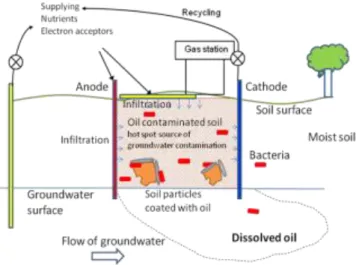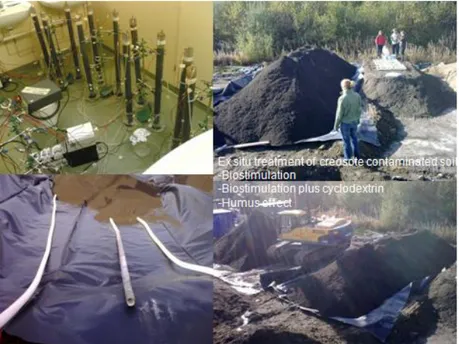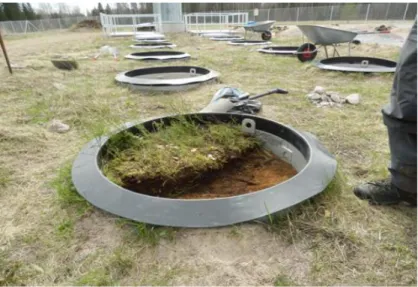DOI: https://doi.org/10.15626/Eco-Tech.2012.007
IN SITU BIOREMEDIATION: TUNING IN THE
LAB SAVES TIME AND MONEY AT
APPLICATION SCALE
Martin Romantschuk
1Riikka Mäkelä
1,2Vuokko Malk
1,2Harri Talvenmäki
3Aki Sinkkonen
1Sari Kauppi
1Suvi Simpanen
1 1University of Helsinki , Dept of Environ. Sci., Niemenkatu 73, FIN-15140,
Lahti, Finland. martin.romantschuk@helsinki.fi; riikka.makela@helsinki.fi;
vuokko.malk@helsinki.fi suvi.simpanen@helsinki.fi
2
University of Helsinki, Palmenia Centre for Continuing Education
Metsontie 41, FIN - 48220 KOTKA, Finland
3
Lahti University of Applied Sciences, Niemenkatu 73, FIN-15140, Lahti,
Finland harri.talvenmaki@lpt.fi
ABSTRACT
For more than 20 years we have tested various approaches for enhancement of bioremediation of sites polluted by organic contaminants. Through collaboration with contractors and site owners, more than 10 actual sites presenting typical problems have been targets for testing and optimization, first by laboratory modeling, and then by applying lab experiences in application scale. Samples from the sites were used in controlled laboratory conditions to build micro- and mesocosm- setups in which biological, physical, and chemical treatments were tested and combined, with the main goal of achieving optimal biostimulation and contaminant degradation. As soon as lab results were available, these were utilized for in situ field purposes. Lab and field tests were run in parallel, so that each new challenge in the field treatment generated modifications in the laboratory testing, and each new full scale treatment method was preceded by laboratory modeling. Successful bioremediation was achieved in most of the target cases. Lab testing also created the knowledge when not to use bioremediation, and this can be regarded as one of the utilities of our results. Fresh oil spills resulting from accidents is a new research topic. While old contaminated sites often can rely on an adapted indigenous microbial community, new spill sites may be less responsive to mere biostimulation, and therefore more active treatment measures may be required. The results from this oil spill simulation performed at a lysimeter field are currently being gathered.
1 INTRODUCTION
Organic contaminants in the soil is a widespread problem that not only may cause damage to local biota, but also poses an ecological and health threat if the contaminants spread to groundwater aquifers and water ways. Therefore sites known to be contaminated should always be assessed preferable by performing both an ecological risk assessment and a health risk assessment. Monitored natural attenuation (MNA) is in many cases a reasonable approach, but often risk assessment calls for active remediation measures. The most common method in Finland for cleaning a site is excavation and treatment ex situ, but recently a variety of in situ methods, both bioremediation and chemical treatments, have been tested and even employed in field conditions (Romantschuk et al. 2000; Simpanen, manuscript in preparation). One bottleneck for a more widespread use of in situ methods is the great variability in the usefulness of each type of treatment. Vital for success is a thorough knowledge of the site and a variety of methods to chose from and, when necessary, to combine. Functionality of a certain method or combination of methods should also, whenever possible, be tested in laboratory conditions before and during field scale application.
We have tested and optimized various combinations of biostimulation, bioaugmentation, extraction, electro-kinetic methods, and the use of previously contaminated soil as a seed for degraders (Kauppi et al. 2011, 2012, Sinkkonen et al. 2012, Suni et al. 2007) The lab results have then been employed for reaching an optimal result at the field site. Slowly generalizations to be used at “any site” begin to emerge.
2 MATERIALS AND METHODS
Methods tested to enhance contaminant removal: 1) gravitational and electro-kinetic infiltration of nutrients, electron-acceptors, bacterial preparations, and surfactants; 2) direct electric heating of soil to reach temperatures for biostimulation; 3) electro-osmotic removal of water for enhancement of soil vapor extraction; 4) bioaugmentation by providing degradation active bacterial seed population in the form of soil types.
Laboratory setups: 1 – 60 L columns filled with contaminated soil directly from the sites, were used in order to mimic conditions and possible activities at field sites. Water containing various testable components was circulated, and both water and soil were sampled and analyzed. Pilot scale tests: Soil research facility with lysimeters with a capacity of ca 1.5 m3
and a height of 2 m. The lysimeters filled with soil of the type found at an oil spill site were exposed to simulated gasoline and diesel spill mimicking an actual accident. Field applications: methods judged to be suitable for each specific site, based on lab trials, were used at field sites. As the situation changed, and the effect of one method was fading without reaching sufficient cleanup, the next lab tested method was ready to be used at the field site. This approach was used until the cleanup goal was reached.
3 RESULTS
3.1 Case I: Old fuel station – treatment in situ
Bacteria suspended in water and solutes in water have been shown to move with the water flow created by electro-osmosis. This possibility was used when introducing missing nutrients (N, P) into diesel and gasoline contaminated soil at a former fuel station.
In order to achieve biostimulation, missing nutrients (N, P) were infiltrated into the soil beneath the fuel pumps (Fig 1). Diesel fuel was efficiently removed (>90%) from the water
permeable portion of the soil, down to ca 2 m below ground, but deeper sections were virtually unaffected. Furthermore, gasoline fractions were poorly removed even from the permeable portion. In order to expand the treatable soil volume, electrodes were installed in two rows, and a DC current was employed. Nutrient rich water was circulated through the soil for one year using electro-osmosis, and the nutrients in combination with the temperature increase, enhanced the diesel degradation throughout the contaminated volume. To keep a steady temperature, a constant voltage of ca 0.5 V/cm was maintained also after the water circulation was abandoned. This also had the effect of drying the soil to reach a level of 8% of the water holding capacity. In laboratory experiments is was established that 83% of the gasoline evaporated in three weeks from dry soil, while only 16% or less evaporated from
soil that was saturated with water, which was the situation at the start of the project. Based on this observation soil vapor extraction equipment was installed (Fig, 2), resulting in sufficient removal of the gasoline from the entire volume of the fuel station soil.
Figure 2: Bioremediation of oil contaminated soil with the help of electro-kinetics. Electrodes and perforated tubes were installed into the soil vertically. A solution containing nutrients were added. In dense soil the transport of liquid from anode to cathode moves bacteria and nutrients through the soil and bacteria can degrade oil. Electron acceptors, oxidative chemicals, enzymes or surfactants can also be introduced.
Figure 2: Perforated tubing was installed into the electro-kinetically dried gasoline contaminated soil. The tubing was connected to a vacuum pump and active charcoal to collect the gasoline.
3.2 Case II: Creosote contaminated soil ex situ
A field test was earlier performed where ca 100m3 of creosote contaminated soil was cleaned
using electro-kinetics and biostimulation (Suni et al. 2007). Later a volume of 800 m3 with an
average PAH concentration of 1000 mg/kg was treated ex situ with similar technology, aided by the use of biosurfactants. The full scale test (Fig. 3) was based on laboratory modeling showing that cyclodextrin (CD) improves the removal of PAH from the soil.
In the field application the challenge was to maintain a sufficient level of moisture in the soil to enable any biological activity. Heaps were sprayed with water with or without surfactants once per week. It was concluded that a more automated and continuous circulation of nutrient and CD amended water would have improved the result.
Figure 3: Testing in columns with water circulation amended with various additives showed that the surfactant cyclodextrine improved the bioavailability and thereby the degradation of PAH in laboratory scale, while in full scale the added effect of CD was smaller, since already circulation of nutrient rich water resulted in sufficient cleaning.
3.3 Case III: Simulated oil spill accident
A fuel transportation traffic accident took place in 2010 in near the city of Iisalmi. Through rapid action a large part of the diesel and gasoline fuel could be collected soon after the accident, but enough of both oil fractions entered the soil to form a threat to the soil ecosystem and the ground water. In the lysimeters at the Jokimaa Soil Research Center in Lahti (Fig. 4) the soil profile of the Iisalmi site was replicated, and the lysimeters were soaked with the same relative amount of diesel and gasoline as at the actual site. After letting the oil infiltrate for one month treatments were divided into (i) monitored natural attenuation (ii) biostimulation using nutrient addition, (iii) chemical oxidation using the Fenton reaction. Microbial community composition is determined by analysis of the 16S ribosomal DNA profile.
Figure 4: Two by one meter (depth x width) lysimeters were filled with sandy soil, and topped with a humus soil layer. Six out of eight lysimeters were soaked with gasoline and diesel, and three cleaning treatments were tested. Final results will be collected in the spring 2013.
4 DISCUSSION
The message of the research presented is that no single method to be used in situ can be named universal and useful in all situations and in all cases. There always needs to be an array of methods to choose from, and it may be important to apply different methods at different stages of the process. Furthermore, every case should be evaluated separately, taking into account local conditions, type of contaminant, available time, etc (Fig. 5). Only with these notions in mind is it possible to make in situ treatment a viable alternative to excavation of contaminated soil.
Figure 5: Suggestion for procedure when evaluating treatability of a site contaminated with organic pollutants. The commonly used technique of excavation and relocation of the contaminated soil should in our opinion be used only if all other options have been deemed unsuitable or inefficient.
5 REFERENCES
Kauppi, S., Romantschuk, M., Strömmer, R., Sinkkonen, A. 2012. Natural attenuation is enhanced in previously contaminated and coniferous forest soil. Environmental Science and Pollution Research, 19, 53-63.
Kauppi, S., Sinkkonen, A., Romantschuk, M. 2011. Enhancing bioremediation of oil hydrocarbon contaminated soil in a boreal climate; comparison of biostimulation and bioaugmentation. International Biodeterioration and Bioremediation 65, 359-368.
Romantschuk, M., Sarand, I., Peltola, R., Petänen, T., Jonsson-Vihanne, M., Yrjälä, K., Koivula, T., Haahtela, K. 2000. Means to improve the effect of in situ bioremediation of soil; an overview of novel approaches. Environmental Pollution 107, 179-185
Sinkkonen A., Kauppi S., Simpanen S., Rantalainen A.L., Strömmer R., Romantschuk M. 2012. Layer of organic pine forest soil on top of chlorophenol-contaminated mineral soil enhances contaminant degradation. Environ Sci Pollut Res (in press).
Suni, S., Malinen, E., Kosonen, J., Silvennoinen, H., Romantschuk, M. 2007. Electrokinetically enhanced bioremediation of creosote-contaminated soil: laboratory and field studies Journal of Environmental Science and Health, Part A 42: 277-287.


